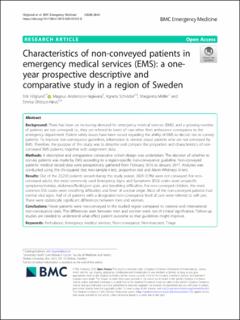| dc.contributor.author | Höglund, Erik | |
| dc.contributor.author | Andersson-Hagiwara, Magnus | |
| dc.contributor.author | Schröder, Ingrid Agneta | |
| dc.contributor.author | Möller, Margareta | |
| dc.contributor.author | Ohlsson-Nevo, Emma | |
| dc.date.accessioned | 2023-01-16T10:00:59Z | |
| dc.date.available | 2023-01-16T10:00:59Z | |
| dc.date.created | 2021-02-25T13:27:51Z | |
| dc.date.issued | 2020 | |
| dc.identifier.citation | BMC Emergency Medicine. 2020, 20:61 1-11. | en_US |
| dc.identifier.issn | 1471-227X | |
| dc.identifier.uri | https://hdl.handle.net/11250/3043629 | |
| dc.description.abstract | Background
There has been an increasing demand for emergency medical services (EMS), and a growing number of patients are not conveyed; i.e., they are referred to levels of care other than ambulance conveyance to the emergency department. Patient safety issues have been raised regarding the ability of EMS to decide not to convey patients. To improve non-conveyance guidelines, information is needed about patients who are not conveyed by EMS. Therefore, the purpose of this study was to describe and compare the proportion and characteristics of non-conveyed EMS patients, together with assignment data.
Methods
A descriptive and comparative consecutive cohort design was undertaken. The decision of whether to convey patients was made by EMS according to a region-specific non-conveyance guideline. Non-conveyed patients’ medical record data were prospectively gathered from February 2016 to January 2017. Analyses was conducted using the chi-squared test, two-sample t test, proportion test and Mann-Whitneys U-test.
Results
Out of the 23,250 patients served during the study period, 2691 (12%) were not conveyed. For non-conveyed adults, the most commonly used Emergency Signs and Symptoms (ESS) codes were unspecific symptoms/malaise, abdomen/flank/groin pain, and breathing difficulties. For non-conveyed children, the most common ESS codes were breathing difficulties and fever of unclear origin. Most of the non-conveyed patients had normal vital signs. Half of all patients with a designated non-conveyance level of care were referred to self-care. There were statistically significant differences between men and women.
Conclusions
Fewer patients were non-conveyed in the studied region compared to national and international non-conveyance rates. The differences seen between men and women were not of clinical significance. Follow-up studies are needed to understand what effect patient outcome so that guidelines might improve. | en_US |
| dc.language.iso | eng | en_US |
| dc.publisher | BMC | en_US |
| dc.rights | Navngivelse 4.0 Internasjonal | * |
| dc.rights.uri | http://creativecommons.org/licenses/by/4.0/deed.no | * |
| dc.title | Characteristics of non-conveyed patients in emergency medical services (EMS): A one-year prospective descriptive and comparative study in a region of Sweden | en_US |
| dc.title.alternative | Characteristics of non-conveyed patients in emergency medical services (EMS): A one-year prospective descriptive and comparative study in a region of Sweden | en_US |
| dc.type | Peer reviewed | en_US |
| dc.type | Journal article | en_US |
| dc.description.version | publishedVersion | en_US |
| dc.source.pagenumber | 1-11 | en_US |
| dc.source.volume | 20:61 | en_US |
| dc.source.journal | BMC Emergency Medicine | en_US |
| dc.identifier.doi | 10.1186/s12873-020-00353-8 | |
| dc.identifier.cristin | 1893694 | |
| cristin.ispublished | true | |
| cristin.fulltext | original | |
| cristin.qualitycode | 1 | |

